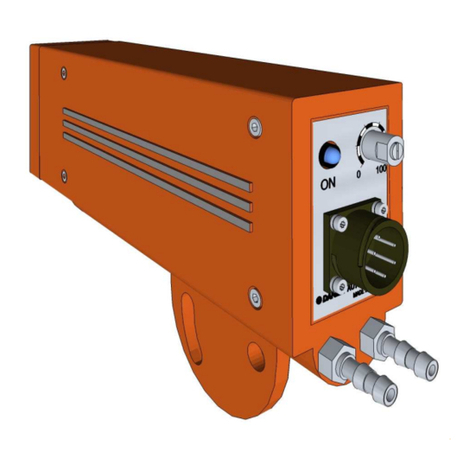
Pag. 7
Manuale d’installazione ed uso
IIttaalliiaannoo
Pag. 6
Danieli Automation - ID6100
44..CCOOLLLLEEGGAAMMEENNTTIIFFOOTTOOCCEELLLLUULLAA55..CCOONNFFIIGGUURRAAZZIIOONNEEDDEELLFFOOTTOORRIILLEEVVAATTOORREE
LMA
B
KUN
H
SR
D
E
F
G
CJ TVP
+24 Vdc
+24 Vdc
IPO
0V
POS
test
0V
0 Vdc0 Vdc
250 Ohm
max
PNP output
NPN output
A
F
C
K
L
P
J
Connector pins
U
Sul lato posteriore del fotorilevatore trovano posto i dispositivi di connessione e segnalazione.
44..11--CCoonnnneessssiioonniieelleettttrriicchhee
Fig. 3(1). Connettore a 19 contatti, tipo MIL
Le uscite analogiche sono galvanicamente isolate rispetto alle uscite digitali, e fanno riferimento
rispettivamente a 0V e 0VE.
22
2
3
1
44..33DDiissppoossiittiivvooddiirraaffffrreeddddaammeennttoo
Fig.3 (3) Attacchi da 1/4" GAS, per mandata e
scarico del circuito di raffreddamento a fluido
predisposto nel corpo del fotorilevatore.
22CCoonnnneettttoorreettiippooMMIILL
ccoonnccoolllleeggaammeennttii
eelleettttrriiccii,,uuttiilliizzzzaarree
ccaavvoosscchheerrmmaattooppeerr
iillccoolllleeggaammeennttooddeel
lllee
uusscciitteeaannaallooggiicchhee..
33VViissttaappoosstteerriioorreeddeellllaa
ffoottoocceelllluullaa,,ccoonn
ddiissppoossiittiivviiddii
ccoonnnneessssiioonneeee
sseeggnnaal
laazziioonnee..
44PPoossiizziioonnaammeennttooddeeiiDDIIPP--SSWWIITTCCHHaallll’’iinntteerrnnooddeell
ffoottoorriilleevvaattoorreeIIDD66110000
33
LED presenza
materiale
Connettore MIL
maschio 19 Poli DIP-SWITCH A DIP-SWITCH B
Connessioni
circuito di
raffreddamento
É possibile configurare le seguenti funzioni:
Range delle uscite analogiche in tensione e
corrente (POS e IPO)
Angolo verticale del campo visivo
(45° o 30°)
Regolazione automatica della sensibilità.
Modalitá di lettura barra singola / multipla.
La configurazione si effettua per mezzo di dip-
switch posti all'interno del fotorilevatore, ai quali
si accede rimuovendo il coperchio laterale.
Sono presenti due banchi di DIP-SWITCH, con-
trassegnati con A e B (figura 4).
55..11IImmppoossttaazziioonneeuusscciittaaiinntteennssiioonnee((PPOOSS))
La tabella seguente descrive come impostare i
DIP-SWITCH Banco A, per la selezione del
range dell'uscita POS (Tensione).
RRaannggeeuusscciittaaSSwwiittcchh::11SSwwiittcchh::22SSwwiittcchh::77
0 ÷ +10V ON OFF OFF
+10 ÷ 0V ON OFF ON
-5 ÷ +5V ON ON OFF
+5 ÷ -5V ON ON ON
-10 ÷ +10V OFF ON OFF
+10 ÷ -10V OFF ON ON
55..22IImmppoossttaazziioonneeuusscciittaaiinnccoorrrreennttee((IIPPOO))
La tabella seguente descrive come impostare i
DIP-SWITCH Banco A, per la selezione del
range dell'uscita IPO (Corrente).
RRaannggeeuusscciittaaSSwwiittcchh::33SSwwiittcchh::44SSwwiittcchh::55SSwwiittcchh::77
4 ÷ 20mA ON OFF OFF OFF
20 ÷ 4mA ON OFF OFF ON
0 ÷ 20mA OFF ON ON OFF
20 ÷ 0mA OFF ON ON ON
NOTA: Le impostazioni di fabbrica sono 0÷10 V
per l'uscita in tensione, e 4÷20 mA per l'uscita
in corrente. Se il rilevatore è montato con la pia-
stra di supporto verso il basso, 0V (o 4 mA) cor-
risponde a presenza materiale nella posizione
inferiore, 10V (o 20 mA) corrisponde a materia-
le nella posizione superiore.
NOTA: in assenza di laminato, l’uscita digitale è disattivata
mentre l'uscita analogica assume il valore del fondo scala
superiore (100%), cioè come se la barra fosse presente, e
fosse localizzata in alto.
55..33IImmppoossttaazziioonneeaannggoolloovviissiivvoo
La tabella seguente descrive come impostare i
DIP-SWITCH Banco A, per la selezione dell'an-
golo visivo.
AAnnggoolloovviissiivvooSSwwiittcchh::88
30 gradi OFF
45 gradi ON
55..44RReeggoollaazziioonneeaauuttoommaattiiccaaddeellllaasseennssiibbiilliittàà
Se la funzione è disattivata (OFF), il periodo di
scansione del CCD (e quindi la velocitá di
aggiornamento dell'uscita analogica di posizio-
ne) è fisso. Se la funzione è abilitata (ON), il
periodo di scansione del sensore CCD viene
modificato automaticamente per adattarsi all'in-
tensitá dell'emissione rilevata (dipendente dalla
temperatura del materiale).
Vista del connettore
lato saldature
PPiinnSSeeggnnaalleeFFuunnzziioonnee
J +24VE 24 VCC Alimentazione
C 0VE 0 VCC Alimentazione
P PFA/ Presenza materiale (uscita NPN)
K PFA Presenza materiale (uscita PNP)
A POS Posizione ansa (uscita in tensione)
L IPO Posizione ansa (uscita in corrente)
U-F 0V 0 Volt riferimento per IPO e POS
E Test 0 Vcc Alimentazione test
G Test 24 Vcc Alimentazione test
44..22DDiissppoossiittiivvooddiisseeggnnaallaazziioonnee
Fig.3 (2) indicatore luminoso a LED di colore
verde che si accende per segnalare lo stato di
"presenza materiale".




























